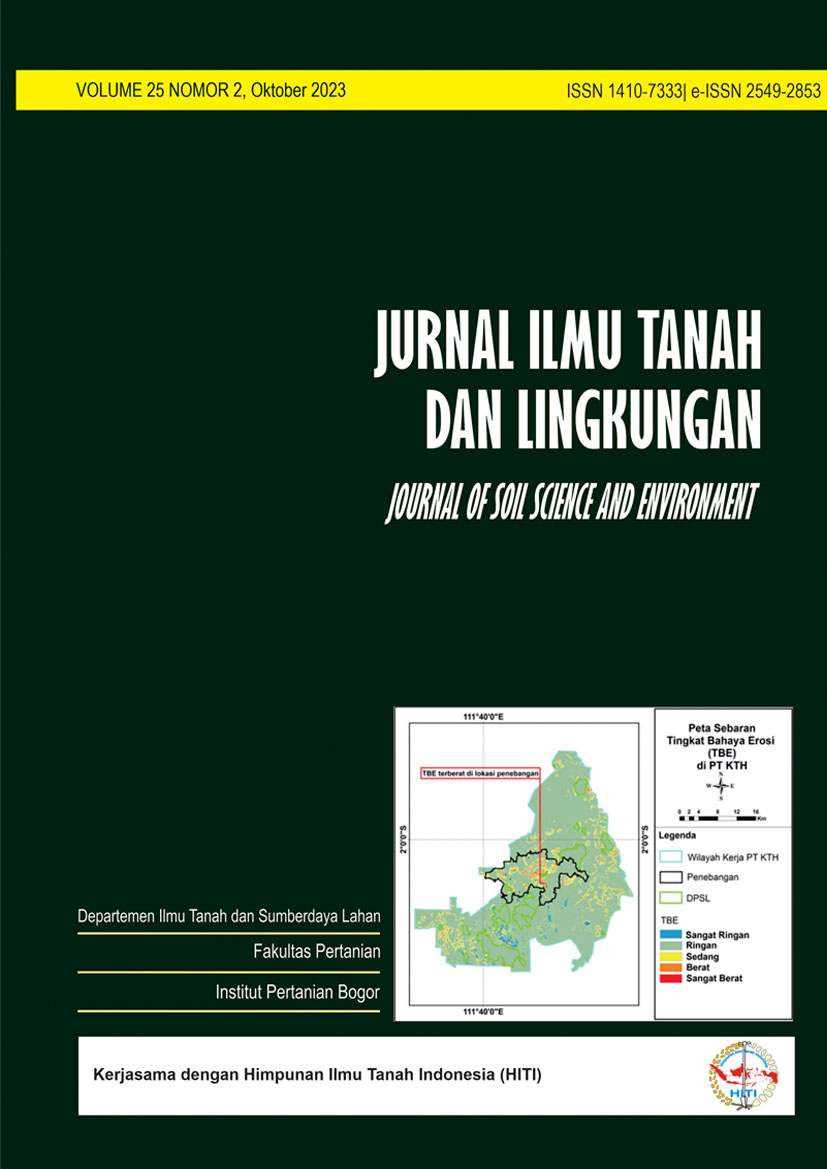Analysis of Land Use and Spatial Patterns Based on Flow Regime Coefficients (FRC) in DAS Air Bengkulu
Abstract
The watershed is a space that has an important role in maintaining the environment and hydrological stability of an area. The causes that often occur are land conversion in the form of vegetation, as well as other land that affects the decline in hydrological functions. The purpose of this study was to determine changes in land use, the stability of the hydrological function of the DAS Air Bengkulu, and spatial pattern-based directions for the DAS Air Bengkulu. The analytical methods used is manual digitization, image visual interpretation, FRC statistical calculations, and watershed management guidelines. Based on the results of the analysis of changes in land use in 2010-2015 there was an increase in the area dominated by residential land (674.97 ha), plantations (606.98 ha), and a dominant decrease in forest land (1,177.25 ha). In the 2015-2020 period, there was a significant increase in dry land/fields of (1,383.09 ha), as well as a dominant decrease in plantation land with an area of (1,202.91 ha). The results of hydrological analysis in 2012 had a low class value of 33.03; in 2015, a low class value of 25.91; and in 2020, a very high class value of 313.49. Based on the land use scenario, the low class in 2012 and 2015 is classified as good so that the hydrology of the watershed runs according to its function with the dominant land use of plantations, which has increased by 62.65% in 2010 and 63.82% in 2015, but the KRA condition in 2020 is included in the bad classification. The land use that caused the KRA class was very high, caused by changes in forest land use, namely 19.77% and plantations, 61.51%, which experienced a decrease in area, while settlements, fields/moors, shrubs, and mines increased. The spatial planning scenario produced by combining KRA classes results in 65% conformity of land use and spatial patterns, 16% transition, and 19% non-alignment. The majority of land uses that are not aligned with spatial patterns come from forests, mining, and plantations. So it is necessary to manage the Air Bengkulu River Basin in a category that is not in line with the directives on land use and conservation.
Downloads
References
Andriansyah O, Mustikasari R. 2011. Gambaran Umum Pengelolaan Air DAS Bengkulu. :36.
Fachrul, M. F., Hendrawan, D., & Sitawati, A. (2007). Land Use and Water Quality Relationships in The Ciliwung River Basin Indonesia. In International Congress River Basin Management.
Hanjani, S.S., M. Ardiansya, D. Nadalia dan S. Sabiham. 2015. Dinamika penggunaan lahan dan perkembangan perkebunan kelapa sawit di Kabupaten Kubu Raya dan Sanggau tahun 1990- 2013. J Tanah Lingk., 17(1): 39-45.
Landis, J. & Koch, G. (1977). The Measurement Of Observer Agreement For Categorical Data, Biometrics 33(1): 159-174.
Lillesand, T.M. and R.W. Kiefer. 1994. Remote Sensing and Image Interpretation. 3rd Ed. John Wiley and Sons, Madison, Wisconsin, USA.
Lisnawati, Y., & Wibowo, A. (2010). Analisis Fluktuasi Debit Air Akibat Perubahan Penggunaan Lahan di Kawasan Puncak Kabupaten Bogor. Jurnal Penelitian Hutan Tanaman, 7(4): 221-226.
Nilda. 2014. Analisis Perubahan Penggunaan Lahan Dan Dampaknya Terhadap HasilAir Di Daerah Aliran Sungai Cisadane Hulu [tesis]. Denpasar. Universitas Udayana.
[Permen] Peraturan Menteri Kehutanan Republik Indonesia Nomor : P-88/Menhut-II/2014 Tentang Hutan Kemasyarakatan. Jakarta
[Permen] Peraturan Menteri Kehutanan Republik Indonesia Nomor: P.32/MENHUTII/2009 tentang Tata Cara Penyusunan Rencana Teknik Rehabilitasi Hutan Dan Lahan Daerah Aliran Sungai (RTKRHL-DAS).
Rosyidie, A., 2013. Banjir: fakta dan dampaknya, serta pengaruh dari perubahan guna lahan. Jurnal Perencanaan Wilayah dan Kota, 24 (3) : 241-249.
Sudaryono, S. (2002). Pemberdayaan Alfisol Untuk Pengembangan Sentra Area Tanam Dan Agribisnis Kacang Tanah Di Indonesia. Buletin Palawija, (4): 84-99.
Supriyono, S. 2018. Critical Land Detection Watershed River Bengkulu and Effect of Coastal Area using Geographic Information System. Sumatra Journal Of Disaster, Geography And Geography Education, 2(1): 30-37. doi:10.24036/sjdgge.v2i1.136
Thomas M. Lillesand, Ralph W. Kiefer. 1993. Lillesand, Thomas M; Dulbahri; Susanto; Kiefer, Ralph W. (1993). Penginderaan Jauh Dan Interpretasi Citra Susanto. Yogyakarta: Gadjah Mada University Press,. 2nd ed. edited by Dulbahri and Susanto. Yogyakarta: Gadjah Mada University Press.
Wahyuningrum.N dan Basuki.T.M. 2019. Analisis Kekritisan Lahan Untuk Perencanaan Rehabilitasi Lahan Das Solo Bagian Hulu. J. Penelit. Pengelolaan Drh. Aliran Sungai. 3(1):27–43.
Yustika, Rahmah D, Suria D. Tarigan, and Untung S. (2019). Simulasi manajemen lahan di das Ciliwung Hulu menggunakan model SWAT [tesis].Bogor : Institut Pertanian Bogor.
Copyright (c) 2023 Jurnal Ilmu Tanah dan Lingkungan

This work is licensed under a Creative Commons Attribution-ShareAlike 4.0 International License.
Department of Soil Science and Land Resources Departemen Ilmu Tanah dan Sumberdaya Lahan, Faculty of Agriculture Fakultas Pertanian, IPB University



















